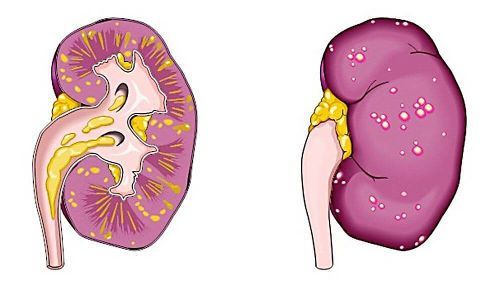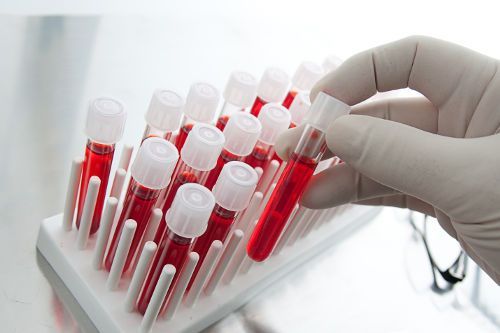Inflammatory process that develops in pyelocaliceal system and a parenchyma of kidneys is called pyelonephritis, manifested polymorphic changes in the tissues of the body.
During the initial inflammation develops when acute form of the disease, the kidney increases in volume, its capsule is thickened, and in the renal substance formed the non-uniform areas.
In the process of acute inflammation are formed centers of infiltration, necrosis, and sclerosis in the tissues of the body are observed in microscopic abscesses tend to merge, the pus penetrates into the tubular system and then into the urine.
The same processes, but more sluggish and with a predominance of sclerotic changes occur in the chronic form of pyelonephritis. With each subsequent relapse or exacerbation of the disease “lost” all the new sections of renal tissue tamasauskiene on scar lesions, which gradually leads to the formation of kidney failure.
All of these changes, which is manifested pyelonephritis at the morphological level, we have a clear expression in the form of clinical symptoms. A patient with a manifestation of the inflammatory process in the kidneys to present a complex characteristic complaints in his blood and urine will be some changes. In addition, the doctor in the external examination will be able to state and provide clear visual evidence of renal damage, in particular, the symptoms of pyelonephritis.
However, in recent decades there have been some difficulties in the early diagnosis of the disease, since there has been a clear trend towards the “blurry” clinical picture of pathology. Pyelonephritis, the symptoms of which were not so striking and characteristic, in our days, requires a deep study of complaints and anamnesis of the patient and laboratory data.
The features of the modern clinical picture of pyelonephritis
Layering of comorbidities, the background state of the body, reduced levels of protective forces, the formation of new strains of microorganisms, characterized by high virulence and resistance to drugs, are just some of the factors that can explain the change of clinical symptoms of inflammation of the kidneys. General and local signs of pyelonephritis in many cases are erased, pronounced aintensive or not a full set.

Purulent abscesses, resulting in pyelonephritis, opened into the cavity of the cups and pelvis of the kidneys
As a result of difficult diagnosis not only chronic, but acute forms of the disease. An active inflammatory process in the kidney is left without competent care, which creates all preconditions for its transition to a chronic form, which also has a sluggish flow and low severity of clinical signs. Therefore, chronic pyelonephritis, symptoms of which can for these reasons be called subclinical symptoms may remain undiagnosed for many years.
Exacerbation can be interpreted wrongly and taken for SARS, adnexitis or lumbago. The result is often accidental discovery of pyelonephritis of the kidneys, during surveys for other diseases, as well as in the later stages of disease, when already developed serious consequences (hypertension, uremia).

But there are some key points by which differential diagnosis of pyelonephritis can be carried out in a more timely manner. Given these, the doctor who examines the patient planning or about other diseases, may be suspected renal pathology. The subsequent appointment of in-depth and more focused research will help to solve the problem of how to define pyelonephritis in a timely manner and to prescribe adequate therapy.
Increase in blood pressure at a young age is the reason for the examination of the kidneys
These are the main factors which will allow the doctor to focus on the pathology of the kidney, the following:
- categories of the population, mostly suffering from pyelonephritis, namely women of all ages, which is associated with the anatomical features of the urinary system;
- predisposition to renal pathologies of older men because of violations of the patency of the urethra in a result of prostate diseases;
- there are some signs of latent pyelonephritis, even when asymptomatic, and a prolonged period of (feeling chills even in the heat) as well as precipitating illness (frequent episodes of cystitis, nocturia, hypertension at a young age, nephroptosis, urolithiasis, diabetes, tuberculosis).
Despite the trend to the uncertainty of the clinical picture, the symptoms of pyelonephritis can still be differentiated from signs of other diseases. On the basis of patient complaints, physical examination, laboratory and instrumental investigations it is possible to diagnose some forms of this renal disease.
Advanced age in men is a risk factor for the development of the pathology of the prostate, and hence pyelonephritis
May manifest as acute pyelonephritis and acute exacerbation of chronic forms of
This form of inflammation of the kidneys develops, as a rule, on the one hand, most of it is on the right. The penetration of infectious microflora occurs hematogenous way, with the formation of inflammatory lesions first occur in the interstices of the organ, then affects the Cup and the renal pelvis structure. The first stage of acute pyelonephritis is characterized by the formation sites of serous inflammation, which then quickly turns into purulent. The same processes occur when hit the infection by ascending.
Destruction of renal tissue by microorganisms, activation of factors of local and General immunity leads to the appearance of the body, and then into the bloodstream, a significant number of dead cells and bacteria, their fragments, toxins, decay products and the so-called pyrogenic substances. All of these components or enter into the urine, or reach the cortex, where is the center of regulation of body temperature. These processes explains the formation of the patient of symptoms of an intoxication that in acute pyelonephritis has a significant intensity.
Usually, onset is sudden, often against the background of complete health.The exceptions are the cases of development of pyelonephritis in a patient has urolithiasis, when the demonstration starts after ureteral obstruction by a stone. Common clinical symptoms are severe the patient’s condition, poor health, a high fever reaching 40 degrees or more. The patient complains of severe chills, pronounced sweating feels. Typical signs of intoxication applies, and headache, lack of appetite, they are joined by nausea, vomiting, pain in the muscles.
Observed local signs of the disease. Is pain on the affected side, often with aching or pulling in nature, with no signs of renal colic. But in situations where acute pyelonephritis was the result of kidney stones, aching pain may be combined with bouts of severe and excruciating pain. Join and voiding, which, however, can be traced not in all cases. The acts of urination can become more, but the quantity of urine is reduced due to high body temperature and sweating, there is pain.

At external examination of the patient noted redness (sometimes the pallor) and dryness of the skin due to body heat and some dehydration. The patient looks weak and apathetic, sluggish responding to inquiries, trying to spare the “sick” side of the body, taking a sitting position or lying on the healthy side, complains of excruciating pain in the lower back. Percussion (positive symptom pasternatskogo) and palpation characteristic sharp increased pain and radiating to the leg, in the abdomen. In addition, there may be marked muscle tension in the inflamed kidneys (lumbar region and hypochondrium). This is due to the involvement in the pathological process of muscle under perinephric and actually protective and lenient sick kidney reflex of the body.
For moderate and severe the patient’s condition required urgent hospitalization. The hospital has been called for to confirm or exclude the diagnosis of pyelonephritis in adults and children of different ages.
These include the following laboratory and instrumental methods:
- blood tests;
- urine;
- ultrasound scan of the kidneys;
- radiographic and radionuclide methods.

Lab tests in pyelonephritis provide a very valuable and comprehensive information. Even in the course of an illness without symptoms in biological environments still determined shifts. The blood in the inflammatory process, regardless of its localization, responds very quickly, but the changes are not specific and are unable to specify the location of the pathological lesion in the kidney. This refers to such indicators as increase in ESR and white cell count, left shift in leukocyte formula. But other criteria, namely a decrease in hemoglobin, red blood cell count, total protein level and simultaneous increase in gamma globulins allows suspected renal pathology. Therefore, the analysis of blood pyelonephritis is of secondary importance.
A blood test can show the presence of inflammation in the body
More valuable in terms of diagnostic examination of urine. The importance possess all the data: the color and smell of urine, specific gravity, transparency, the composition of the urinary sediment, the presence of salts. The degree of bacteriuria (bacteria in urine) in most cases, directly associated with the severity of pyelonephritis. Another indicator, the amount of protein, is not much exceeded. In addition, pyelonephritis in most cases, the urinary pH shifted to the alkaline side. But this parameter doesn’t work during pregnancy and after childbirth, when the predominant use of human milk-vegetable products.
Very valuable information can be obtained when performing ultrasound of the kidneys. The formation of infiltrative and purulent foci, increasing the size of the body and obstructions to the normal outflow of urine, manifested certain ajopringue. This thickening of the contour and deformation of the capsule, the expansion of the cups and pelvis, focal changes (sclerosis and infiltration) within the renal parenchyma, reducing its thickness. Ultrasound scanning can diagnose urolithiasis, nephroptosis, polycystic kidney disease, neurogenic bladder.
Other instrumental diagnostic methods are rarely used when you want to get more information. Can be applied urography, computed tomography. Radionuclide methods have very limited indications, but is able to clearly “see” a functioning part of the kidney and its sklerozirovanie areas, which is very important for differential diagnosis and prognosis for the patient.
Characteristics of the clinical picture of the disease in a specific patient, data of laboratory and instrumental diagnosis should be used in combination. Only in this case pyelonephritis is diagnosed on time, and competent medical measures will help the patient to maintain health.



